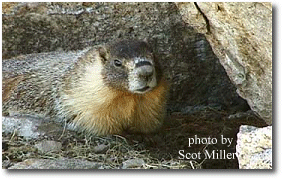| Natural History | Bears | Food Storage | Wildlife Safety |
| Natural History | Bears | Food Storage | Wildlife Safety |
Natural History  The varied topography of Yosemite's wilderness hosts about 1,460 species of plants in over 40 recognized plant communities. These, in turn, are home to numerous invertebrate and vertebrate species, including 78 species of mammals, 247 of birds, 17 of amphibians, 22 of reptiles, 11 of fish, and numerous invertebrates. Wilderness users must understand they are visitors to the homes of these residents and behave in ways that do not upset or destroy their balance of life. Consequences of improper human behavior to the inhabitants or their habitat can be extremely destructive if not deadly. Campfires above 9600', for instance, eliminates necessary habitat and nesting sites. Feeding wildlife, either intentionally or not, encourages unnatural and potentially dangerous behavior and disrupts normal ecological processes. The information in this section highlights bears and proper food storage both in the wilderness and at the trailhead. Wilderness users must take similar care in everything they do in the backcountry to minimize their impact on the natural systems there. Users should also be aware of potential threats to themselves and learn more about mountain lions, poison oak, lyme disease, rattlesnakes or other hazards.
|
http://www.nps.gov
File created 9/99 Hayes Roberts
Updated
Yosemite National Park Division
of Interpretation